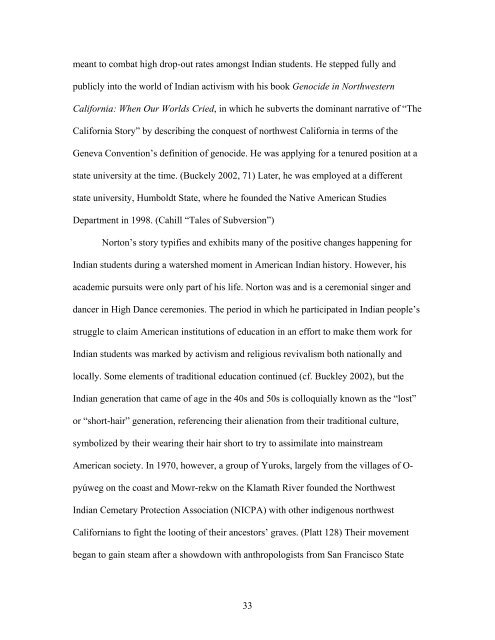The Intersection of Karuk Storytelling and Education
The Intersection of Karuk Storytelling and Education
The Intersection of Karuk Storytelling and Education
Create successful ePaper yourself
Turn your PDF publications into a flip-book with our unique Google optimized e-Paper software.
meant to combat high drop-out rates amongst Indian students. He stepped fully <strong>and</strong><br />
publicly into the world <strong>of</strong> Indian activism with his book Genocide in Northwestern<br />
California: When Our Worlds Cried, in which he subverts the dominant narrative <strong>of</strong> “<strong>The</strong><br />
California Story” by describing the conquest <strong>of</strong> northwest California in terms <strong>of</strong> the<br />
Geneva Convention’s definition <strong>of</strong> genocide. He was applying for a tenured position at a<br />
state university at the time. (Buckely 2002, 71) Later, he was employed at a different<br />
state university, Humboldt State, where he founded the Native American Studies<br />
Department in 1998. (Cahill “Tales <strong>of</strong> Subversion”)<br />
Norton’s story typifies <strong>and</strong> exhibits many <strong>of</strong> the positive changes happening for<br />
Indian students during a watershed moment in American Indian history. However, his<br />
academic pursuits were only part <strong>of</strong> his life. Norton was <strong>and</strong> is a ceremonial singer <strong>and</strong><br />
dancer in High Dance ceremonies. <strong>The</strong> period in which he participated in Indian people’s<br />
struggle to claim American institutions <strong>of</strong> education in an effort to make them work for<br />
Indian students was marked by activism <strong>and</strong> religious revivalism both nationally <strong>and</strong><br />
locally. Some elements <strong>of</strong> traditional education continued (cf. Buckley 2002), but the<br />
Indian generation that came <strong>of</strong> age in the 40s <strong>and</strong> 50s is colloquially known as the “lost”<br />
or “short-hair” generation, referencing their alienation from their traditional culture,<br />
symbolized by their wearing their hair short to try to assimilate into mainstream<br />
American society. In 1970, however, a group <strong>of</strong> Yuroks, largely from the villages <strong>of</strong> O-<br />
pyúweg on the coast <strong>and</strong> Mowr-rekw on the Klamath River founded the Northwest<br />
Indian Cemetary Protection Association (NICPA) with other indigenous northwest<br />
Californians to fight the looting <strong>of</strong> their ancestors’ graves. (Platt 128) <strong>The</strong>ir movement<br />
began to gain steam after a showdown with anthropologists from San Francisco State<br />
33
















